How to Calculate Solar Panel and Battery for Starlink?
- Richard Wang
- November 2, 2024
- 4:29 pm

Preface
Starlink is increasingly used for rural Internet connections. Its ability to connect anywhere greatly facilitates network coverage in rural areas. However, another key challenge in deploying Starlink in rural areas is power supply. In many areas, there is no power grid for power supply. In this case, solar power becomes an inevitable choice. This article will introduce how to calculate solar panel and battery for Starlink based on the power consumption of different Starlink models.
Table of Contents
1.Starlink Models Difference
In order to find out how to calculate solar panel and battery for Starlink, we first need to find out the product model of the Starlink terminal you are using to get its power consumption parameters. You can find out the power consumption of each Starlink model from the following link:

It is recommended to use the maximum value of average when calculating, that is:
Starlink Standard Actuated: 75W
Starlink Standard: 100W
Starlink Enterprise: 100W
Starlink Mini: 40W
Starlink High Perfrmance: 150w
Starlink Flat High Perfrmance: 150W
When calculating, you can adjust it at the end according to the scene and the bandwidth used.
2.Battery Capacity Calculation
2.1 Starlink Model Assumption
In subsequent calculations, we will use the Starlink Standard Actuated as the standard, that is, the power consumption is 75W.
2.1 Define System Runtime(System Autonomy Time)
The so-called system runtime or system autonomy time refers to the operating time of the Starlink solar system on its own batteries when there is no solar input. This parameter is generally determined by balancing the customer’s own budget and local climate conditions. It can be imagined that if a region often rains and the rainy days are very long, then the system runtime needs to be defined longer. On the contrary, it is defined shorter.
The longer the system runtime, the better the availability of the entire system, but this will greatly increase the investment in batteries. Therefore, it is necessary to plan uniformly based on the customer’s own budget, the importance of the Starlink deployment site, and the local climate conditions.
In our example, we define the system runtime as 48 hours.
2.2 Calculate the Power(In kWh) Needed for System Runtime
We already know in the previous chapter that Starlink Power Consumption = 75W, System Runtime = 48Hours, so the formula for calculating the power needed for system runtime is as follows:
Power Needed for System Runtime(Wh) = Starlink Power Consumption(Watts) * System Runtime(Hours)
= 75Watts * 48 Hours
= 3600Wh(Watts-hour)
3600Wh is 3.6kWh. This calculation result will be used to calculate the battery capacity in the next step. If you are not clear about the concept of kWh, you can go to the section Understand kWh in the following link article to check:
2.4 Understand Battery Voltage and Ah(Amp-hours)
Before explaining the calculation of battery capacity, you need to understand a concept, which is the battery voltage of the solar controller or solar inverter. Different models and brands of solar controllers or solar inverters have different battery voltages, so you need to first clarify the battery voltage you need. Let’s take a solar controller from Morning Star as an example:
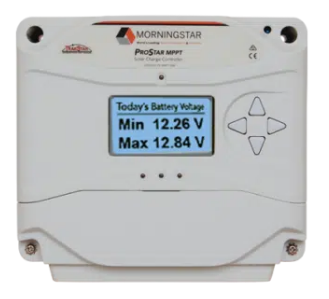
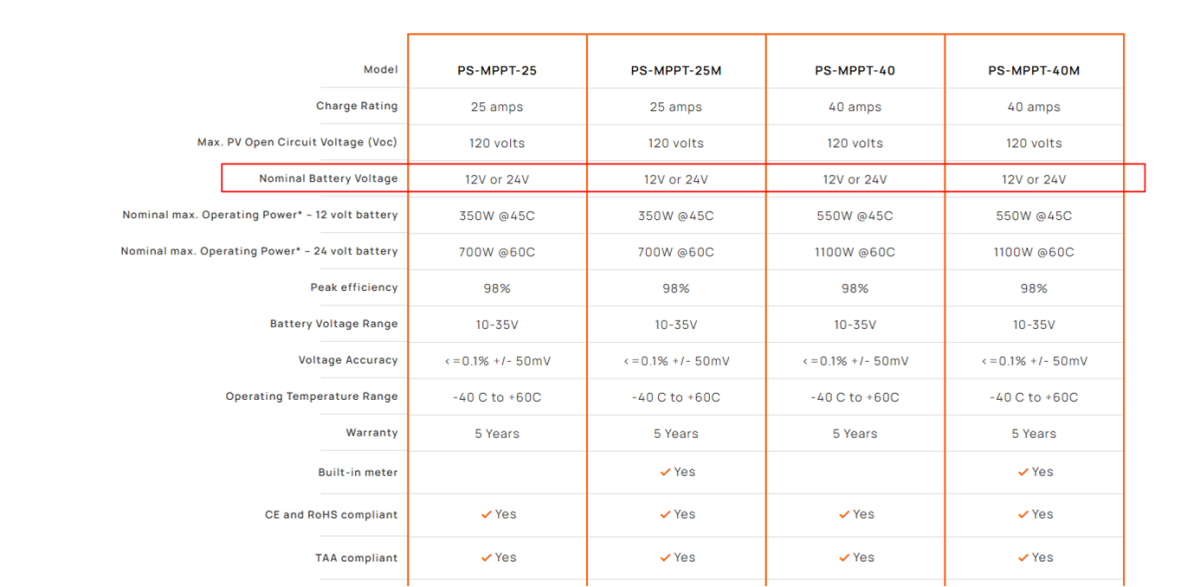
The battery voltage of this solar controller is 12V or 24V. You can choose the battery according to your needs.
The advantage of using 12V voltage is that you can purchase the more common lead acid battery on the market. Their voltage is 12V and the price will be relatively cheap.
If 24V voltage is used, the current of the entire system will be half as small, which is good for reducing the heat of the system. But if you still use lead acid battery, you need to connect two batteries in series to reach 24V voltage. Of course, you can also buy 24V lithium battery.
In the subsequent calculation, we define the battery voltage as 12V.
Please note that we have previously calculated how much power is needed for 48 hours of system runtime, and the result is 3600Wh. Now, the calculation of Battery Capacity can be understood as how large a battery is needed for this 3600Wh of power. Please note that the capacity of a general battery is determined by Amp-hours and Battery Voltage. Here are two examples:
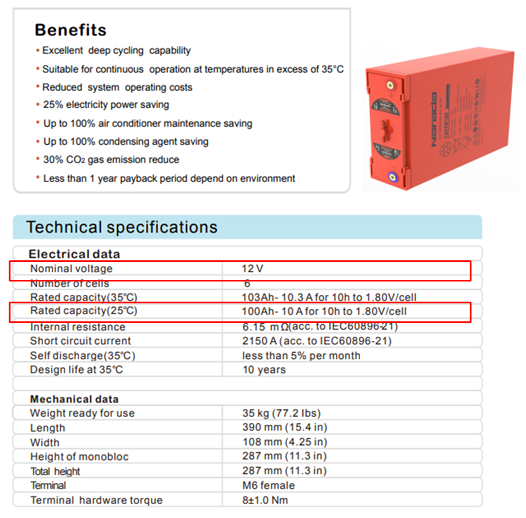

According to the above picture, we read the battery voltage or the nominal voltage, as 12V. And its battery amp-hours is 100Ah. Then, substituting it into the formula, we can get the following calculation:
Battery Capacity(In Wh) = Battery Voltage * Battery Amp-hours
= 12V*100Ah
= 1200Wh
Battery Capacity(In kWh)= Battery Capacity(In Wh) /1000
= 1200Wh/1000
=1.2kWh
According to the above picture, we read the battery voltage or the nominal voltage, as 48V. And its battery amp-hours is 100Ah. Then, substituting it into the formula, we can get the following calculation:
Battery Capacity(In Wh) = Battery Voltage * Battery Amp-hours
= 48V*100Ah
= 4800Wh
Battery Capacity(In kWh)= Battery Capacity(In Wh) /1000
= 4800Wh/1000
=4.8kWh
For detailed explanations of these contents, you can also jump to the following articles for details:
2.5 Calculate Battery Capacity
Based on the explanation in the previous section, the model of the Starlink terminal we selected is Starlink Standard Actuated, with a power consumption of 75W. The set system runtime is 48 hours, the power needed for system runtime is 3600Wh, and the battery voltage is 12V. This information is summarized in the following table:
Starlink Power Consumption | System Runtime | Power Needed for System Runtime | Battery Voltage |
75W | 48hours | 3600Wh | 12V |
With this information we can start to calculate how big a battery is needed. The calculation formula and process are as follows:
Battery Capacity(Ah) = Power Needed for System Runtime(Wh)/Battery Voltage
= 3600Wh/12V
= 300Ah
Please note that solar controllers generally have protection for battery charge and discharge. When discharging, they will only discharge 80% of the battery capacity. (Because this can maximize the battery life)This means that if we actually need 300Ah, we’d better increase it by 20% when configuring.
Battery Capacity Consider Margin(Ah) = Battery Capacity(Ah)*120%
= 300Ah*120%
= 360Ah
We fill in the results of our calculations into our table:
Starlink Power Consumption | System Runtime | Power Needed for System Runtime | Battery Voltage | Battery Capacity(Ah) | Battery Capacity Consider Margin(Ah) |
75W | 48hours | 3600Wh | 12V | 300Ah | 360Ah |
3.Starlink Solar System Topology
3.1 System Topology Understanding
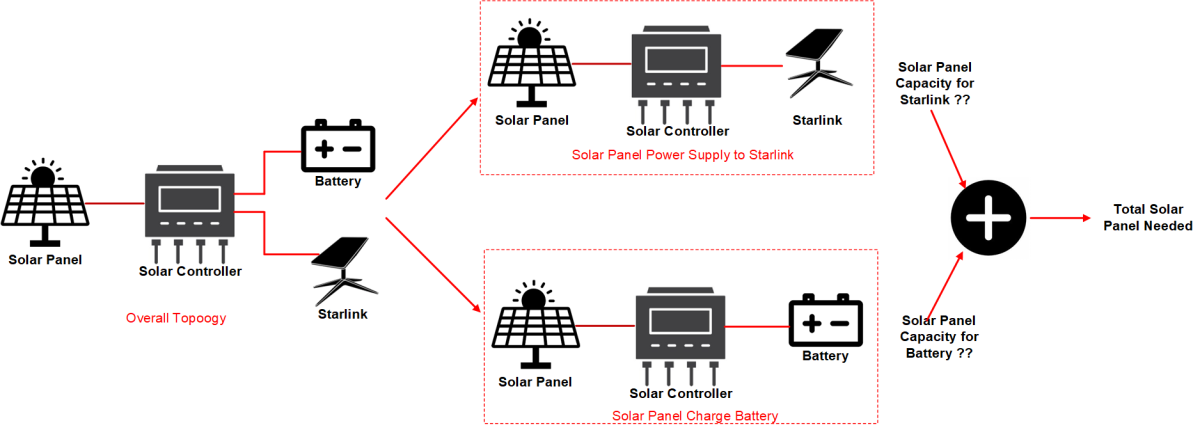
Before we calculate the solar panel capacity, we need to understand that the entire solar system has two parts when it is working:
(1) The solar panel provides power to Starlink, this part actually is during the day solar panel provide power to Starlink, during the night battery provide power to Starlink. We make a very rough assumption that Starlink relies on solar panels for 12 hours during the day and relies on batteries for 12 hours at night.
(2) When the battery is empty because no sunshine for 48hours,the solar panel charges the battery
When there is no sun, the battery discharges to provide energy for Starlink, which is the system runtime mentioned in the previous section.
It is not very easy to understand when these tasks are combined. Therefore, we will calculate them separately in the subsequent steps for easier understanding.
We first divide the calculation into two parts. The first part calculates the solar panel power supply to Starlink. The second part calculates the solar panel charge battery. Finally, we combine the solar panel capacity required by the two parts to get the final answer.
4.Calculate Solar Panel Capacity for Starlink
4.1 Calculate Starlink Power Needed Per Day(In Watts-hour)
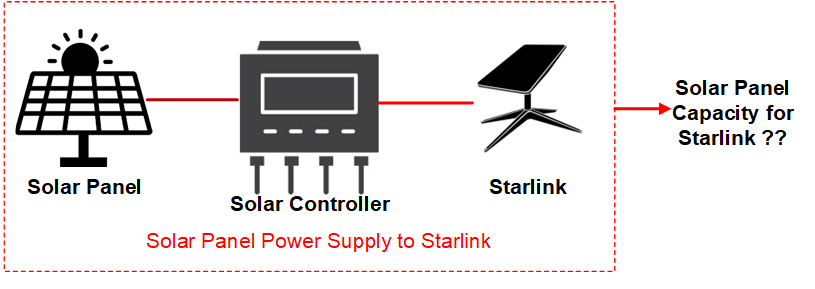
First of all, as shown in the figure above, we first calculate the solar panel capacity required by Starlink.We have previously found that the power consumption of the assumed Starlink model is 75W. Note that we roughly assumed that Starlink relies on solar panels for 12 hours during the day and relies on batteries for the other 12 hours at night.
so we can calculate the total amount of power consumed by Starlink for 12 hours a day:
Starlink Power Needed During the Day(Wh) = Starlink Power Consumption(Watts)*Time(Hours)
= 75W*12Hours
= 900Wh
4.2 Find Your Site Location Solar Potential
The solar potential in different regions of the world is completely different. You can check it on the following website:
https://globalsolaratlas.info/
Assuming that our site is in Panama City, you can use this website as shown below:
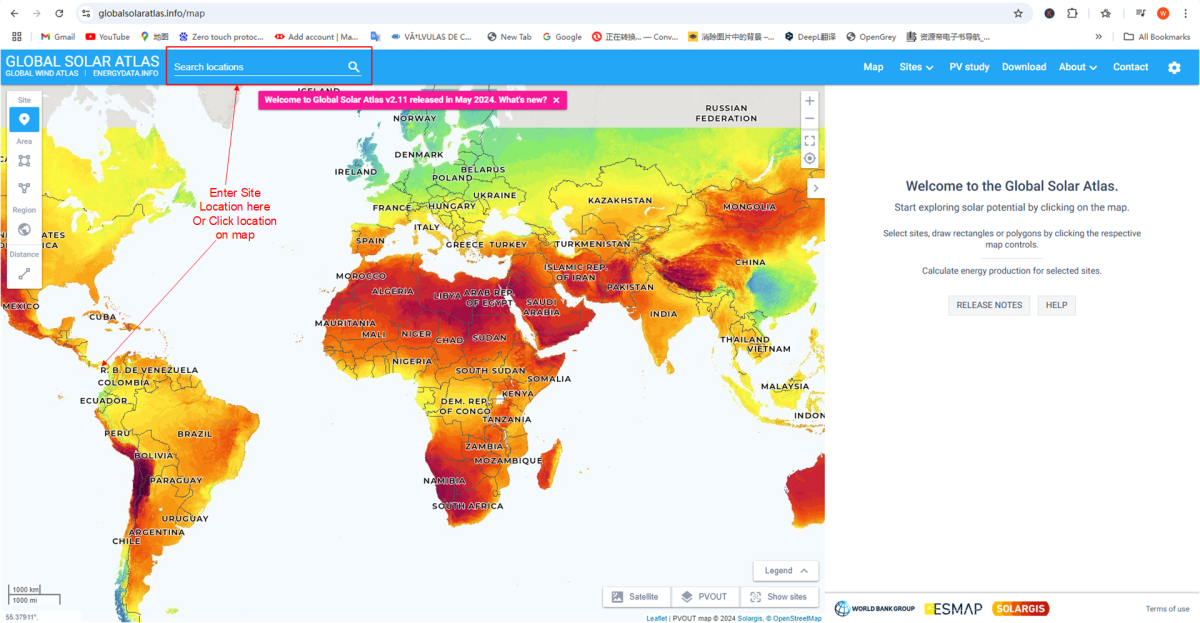
Please note that after jumping out of the site location solar potential, the default display is Per year resource. Please select Per day as shown below:
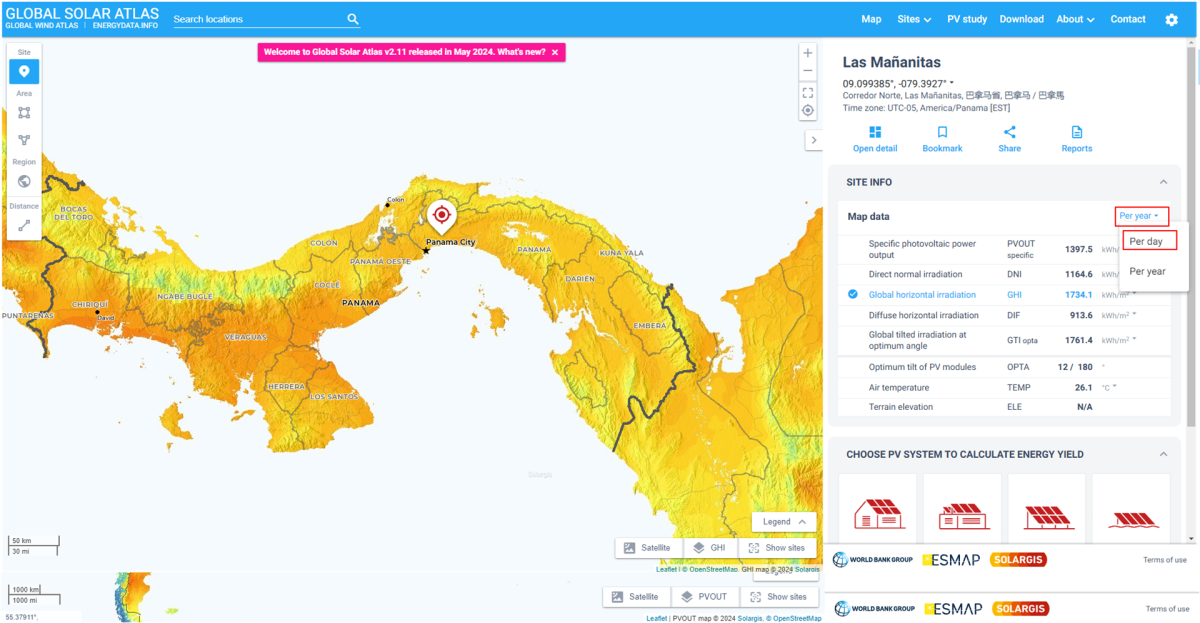
Then we need the parameter of global horizontal irradiation, which we find is 4.751kWh/m2 per day.
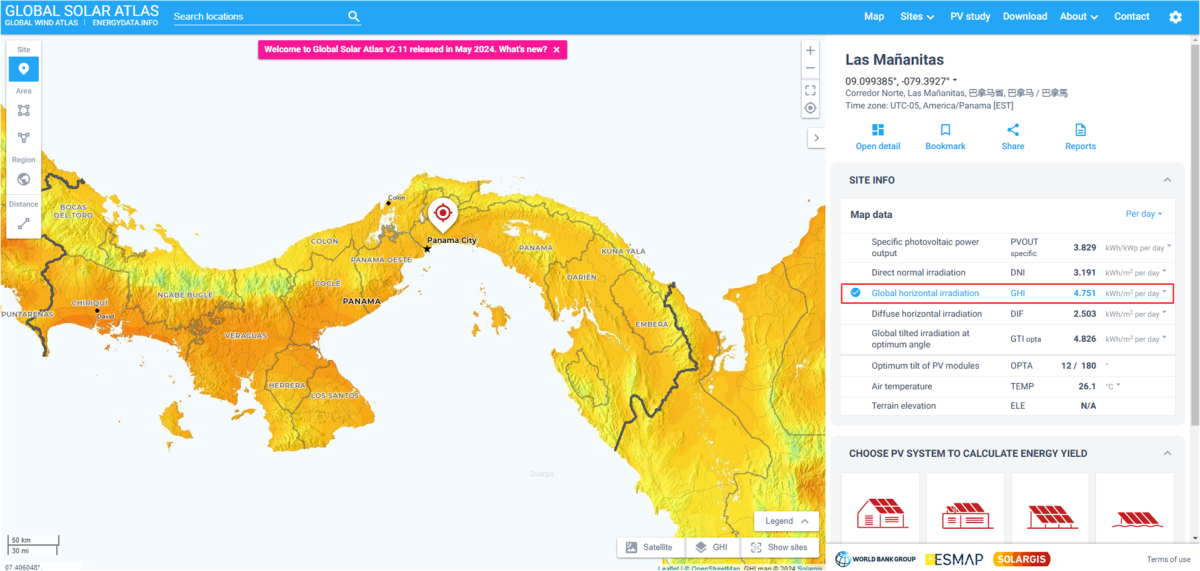
4.3 Standard Solar Radiation
Average annual solar radiation arriving at the top of the Earth’s atmosphere is roughly 1361 W/m2. The Sun’s rays are attenuated as they pass through the atmosphere, leaving maximum normal surface irradiance at approximately 1000 W/m2 at sea level on a clear day.
This parameter was defined in ISO 9845-1:2022
We will use this parameter in subsequent calculations, but it is not recommended to study it in depth, as it is of little help to our entire calculation. We only need to use Standard Solar Radiation = 1000W/m2
4.4 Calculate Solar Panel Capacity for Starlink
Starlink Power Consumption | Starlink Power Needed for During the Day(12Hours) | Horizontal Irradiation of the Site | Solar Panel Capacity for Starlink Needed |
75W | 900Wh=0.9kWh per day | 4.751kWh/m2 per day |
The above is the information we have calculated or collected so far.
First, we from the following calculation you could know the area of the solar panel we need (Square meters)
Area of the Solar Panel Needed for Starlink= Starlink Power Needed During the Day/Horizontal Irradiation of the Site(kWh/m2)
= 0.9kWh/4.751kWh/m2
= 0.189m2
Then we know the solar panel capacity needed for Starlink:
Solar Panel Capacity Needed for Starlink = Area of the Solar Panel Needed for Starlink(m2)*Standard Solar Radiation(W/m2)
= 0.189m2*1000W/m2
= 189W
So the solar panel capacity needed for Starlink is 189W and we fill the final table
Starlink Power Consumption | Starlink Power Needed for During the Day(12Hours) | Horizontal Irradiation of the Site | Solar Panel Capacity for Starlink Needed |
75W | 900Wh=0.9kWh per day | 4.751kWh/m2 per day | 189W |
5.Calculate Solar Panel Capacity for Battery
5.1 Define Time to Charge Battery Fully

As shown in the figure above, in this step we calculate the solar panel capacity required by the battery. We need to define a very important parameter, the time to charge battery fully. Although a short time helps the availability and reliability of the system, it will cause the solar panel to be too large. This will cause problems in both installation and cost. If the time is defined too long, the system availability will be significantly reduced, and the system is likely to be cut off during continuous rainy days. This needs to be considered comprehensively according to the project situation.
In this case, we define Time Charge Battery Fully as two days.
5.2 Calculate Solar Panel Capacity for Battery
So the solar panel capacity needed for Starlink is 189W and we fill the final table
Starlink Power Consumption | System Runtime | Power Needed for System Runtime | Battery Voltage | Battery Capacity(Ah) | Battery Capacity Consider Margin(Ah) | Time to Charge Battery Fully | Horizontal Irradiation of the Site | Solar Panel Capacity for Battery |
75W | 48hours | 3600Wh | 12V | 300Ah | 360Ah | 2 Days | 4.751kWh/m2 per day | ?? |
The above is the information we have calculated or collected so far.
First, we from the following calculation you could know the area of the solar panel we need (Square meters)
Area of the Solar Panel Needed for Battery= Power Needed for System Runtime/(Horizontal Irradiation of the Site(kWh/m2)*Days)
= 3.6kWh/(4.751kWh/m2*2)
= 0.378m2
Why Horizontal Irradiation of the Site multiple 2 is because we have 2 days to charge the battery
Solar Panel Capacity Needed for Battery= Area of the Solar Panel Needed for Battery(m2)*Standard Solar Radiation(W/m2)
= 0.378m2*1000W/m2
= 378W
So the solar panel capacity needed for battery is 378W and we fill the final table
Starlink Power Consumption | System Runtime | Power Needed for System Runtime | Battery Voltage | Battery Capacity(Ah) | Battery Capacity Consider Margin(Ah) | Time to Charge Battery Fully | Horizontal Irradiation of the Site | Solar Panel Capacity for Battery |
75W | 48hours | 3600Wh | 12V | 300Ah | 360Ah | 2 Days | 4.751kWh/m2 per day | 378W |
6.Add Solar Panel Capacity of Starlink and Battery
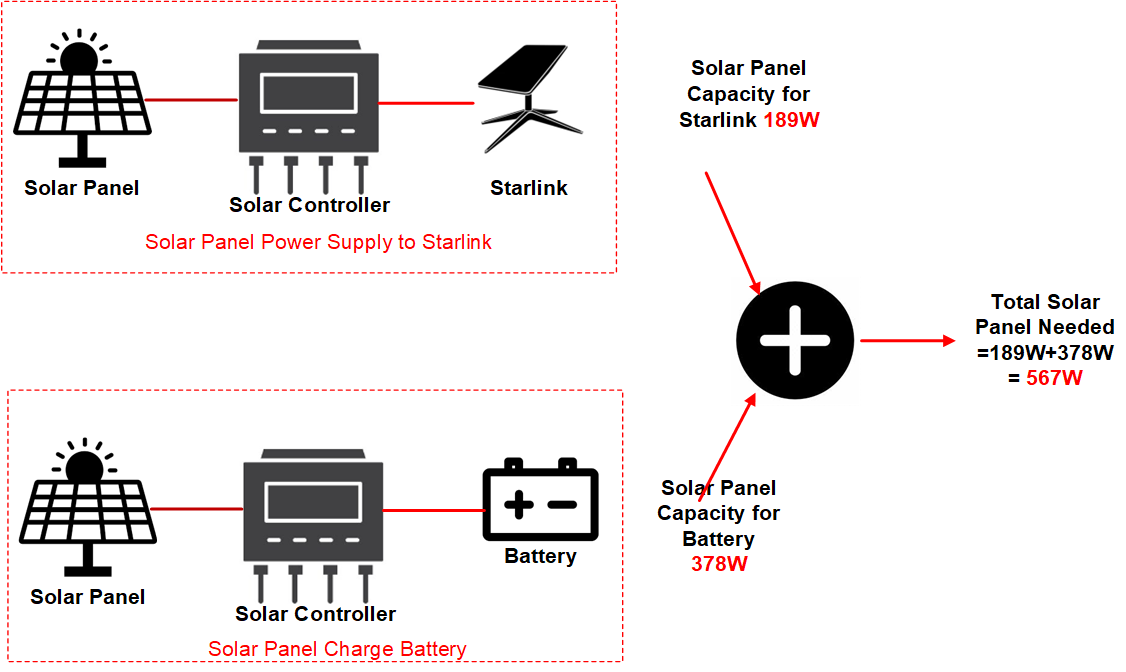
Starlink Power Consumption | Starlink Power Needed for During the Day(12Hours) | Horizontal Irradiation of the Site | Solar Panel Capacity for Starlink Needed |
75W | 900Wh=0.9kWh per day | 4.751kWh/m2 per day | 189W |
Starlink Power Consumption | System Runtime | Power Needed for System Runtime | Battery Voltage | Battery Capacity(Ah) | Battery Capacity Consider Margin(Ah) | Time to Charge Battery Fully | Horizontal Irradiation of the Site | Solar Panel Capacity for Battery |
75W | 48hours | 3600Wh | 12V | 300Ah | 360Ah | 2 Days | 4.751kWh/m2 per day | 378W |
From the previous calculation, we can get Solar Panel Capacity for Starlink Needed = 189W, Solar Panel Capacity for Battery = 378W. We add them together to get the final answer:
Solar Panel Capacity Total = Solar Panel Capacity for Starlink Needed(W) + Solar Panel Capacity for Battery(W)
= 189W+ 378W
= 567W
7. Line Loss and Margin Consideration
Please note that the power generated by the solar panel is lost during the line transmission process. We generally consider a 20% loss, so we need to add 20% to the calculation in the previous step:
Solar Panel Capacity Total Consider Line Loss Margin = Solar Panel Capacity Total * 120%
= 567W*120%
= 680W
8. Summary
Battery Capacity(Ah) | Battery Capacity Consider Margin(Ah) | Battery Voltage | Solar Panel Capacity | Solar Panel Capacity Consider Margin |
300Ah | 360Ah | 12V | 567W | 680.4W |
The above figure shows our final calculation results. The following is an explanation of the entire calculation process:
First, we need to calculate the battery capacity required by the system. This requires defining how many hours the system runtime is, and then calculating how many Wh is required:
Power Needed for System Runtime = Starlink Power Consumption(Watts) * System Runtime(Hours)
Then convert the battery capacity in Ah based on the battery capacity in Wh and the battery voltage
Battery Capacity(Ah) = Power Needed for System Runtime(Wh)/Battery Voltage
It is necessary to consider that the solar system will not discharge the battery 100%, so add a 20% margin:
Battery Capacity Consider Margin(Ah) = Battery Capacity(Ah)*120%
Let’s start calculating the Solar Panel Capacity by dividing it into two parts: one is the solar panel capacity required for Starlink to work during the day, and the other is the solar panel capacity required for battery charging:
Calculate how much power Starlink uses during the day, assuming the daytime lasts 12 hours
Starlink Power Needed During the Day(Wh) = Starlink Power Consumption(Watts)*Time(Hours)
Standard Solar Radiation is a standard parameter defined by ISO 9845:
Standard Solar Radiation = 1000W/m2
Calculate the area of the solar panel required for Starlink:
Area of the Solar Panel Needed for Starlink= Starlink Power Needed During the Day/Horizontal Irradiation of the Site(kWh/m2)
Calculate the capacity of the solar panel required by Starlink:
Solar Panel Capacity Needed for Starlink = Area of the Solar Panel Needed for Starlink(m2)*Standard Solar Radiation(W/m2)
Let’s start calculating the solar panel capacity required for the battery. Note that we need to first assume how long it takes to fully charge the battery. The formula uses Days,First calculate the area of the solar panel:
Area of the Solar Panel Needed for Battery = Power Needed for System Runtime/(Horizontal Irradiation of the Site(kWh/m2)*Days)
Then calculate the solar panel capacity needed for battery based on the area of solar panel for battery and standard solar radiation:
Solar Panel Capacity Needed for Battery= Area of the Solar Panel Needed for Battery(m2)*Standard Solar Radiation(W/m2)
Finally, add up the solar panel capacities calculated by Starlink and the battery:
Solar Panel Capacity Total = Solar Panel Capacity for Starlink Needed(W) + Solar Panel Capacity for Battery(W)
It is necessary to consider the line loss of the solar panel and increase the margin by 20%:
Solar Panel Capacity Total Consider Line Loss Margin = Solar Panel Capacity Total * 120%
9. Conclusion
Please note that the above calculation process has been greatly simplified for ease of understanding. The purpose is to help you better understand How to Calculate Solar Panel and Battery for Starlink. However, in reality, the deployment scenario of Starlink is far from that simple. The load is not just Starlink itself, and there are some special circumstances in different regions to consider, such as weather, load characteristics, temperature and other factors. For a deeper understanding, it is recommended to consult with Edgeware sales staff so that we can design for your scenario.

